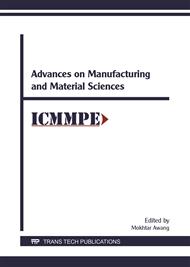p.111
p.118
p.125
p.133
p.139
p.145
p.155
p.163
p.173
Fundamental Research on Hobbing and Finish-Hobbing in Dry and with MQL System
Abstract:
This paper deals with hobbing and finish-hobbing that considers the machine environment when using various hard hob materials. Experiments were conducted by simulating hobbing by fly tool cutting on a milling machine. The results are summarized as follows. (1) Under the condition of hobbing with TiN-coated tools in dry cutting and with a minimal quantity of lubricant (MQL) system, P20 and P30 hob materials as the substrate show stable cutting and do not cause tool failure. The flank wear obtained with P30 is less than that obtained with P10 and P20 in the case of the coated TiAlN film tool. The MQL system shows flank wear reduction compared with dry cutting. (2) Under the condition of finish-hobbing, when using the TiN-coated tool, the flank wear obtained with dry cutting is smaller than that obtained with the MQL system. The flank wear increases in the order of P10, P20 and P30 hob materials, and the P10 hob material is effective. The TiAlN-coated P30 tool decreases flank wear and is suitable for finish-hobbing in dry cutting and with the MQL system. (3) Under the condition of hobbing, the finished surface roughness obtained with the MQL system when using TiN-and TiAlN-coated tools is smaller than that obtained by dry cutting. (4) Under the condition of finish-hobbing, the finished surface roughness obtained with TiN-and TiAlN-coated P30 is small in dry cutting and with the MQL system.
Info:
Periodical:
Pages:
139-144
Citation:
Online since:
June 2017
Authors:
Keywords:
Price:
Сopyright:
© 2017 Trans Tech Publications Ltd. All Rights Reserved
Share:
Citation:


